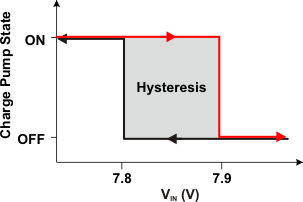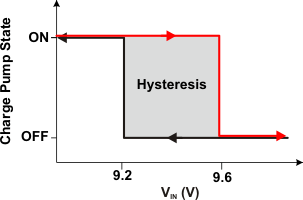SLVSAA0E November 2010 – March 2020 TPS7A6201-Q1
PRODUCTION DATA.
- 1 Features
- 2 Applications
- 3 Description
- 4 Revision History
- 5 Pin Configuration and Functions
- 6 Specifications
- 7 Detailed Description
- 8 Application and Implementation
- 9 Power Supply Recommendations
- 10Layout
- 11Device and Documentation Support
- 12Mechanical, Packaging, and Orderable Information
Package Options
Refer to the PDF data sheet for device specific package drawings
Mechanical Data (Package|Pins)
- KTT|5
Thermal pad, mechanical data (Package|Pins)
- KTT|5
Orderable Information
7.3.4 Charge Pump Operation
This device has an internal charge pump which turns on or off depending on the input voltage and the output current. The charge pump switching circuitry shall not cause conducted emissions to exceed required thresholds on the input voltage line. For a given output current, the charge pump stays on at lower input voltages and turns off at higher input voltages. The charge pump switching thresholds are hysteretic. Figure 16 and Figure 17 shows typical switching thresholds for the charge pump at light (IOUT < ~2 mA) and heavy (IOUT > ~2 mA) loads respectively.
 Figure 16. Charge Pump Operation at Light Loads
Figure 16. Charge Pump Operation at Light Loads  Figure 17. Charge Pump Operation at Heavy Loads
Figure 17. Charge Pump Operation at Heavy Loads